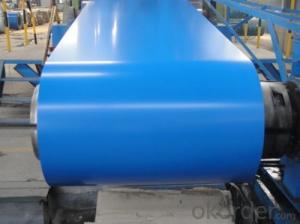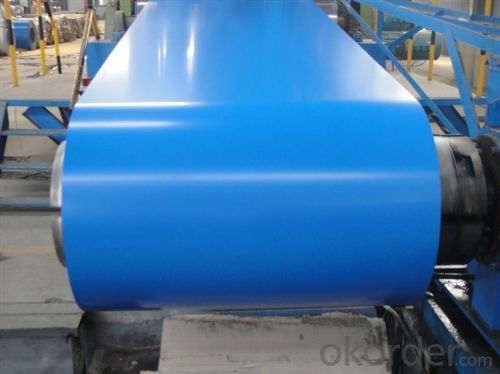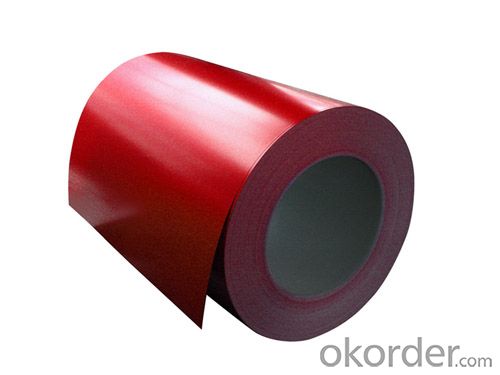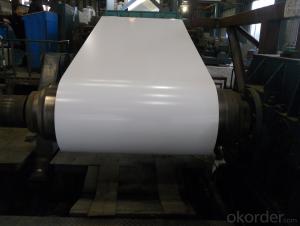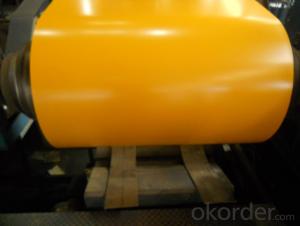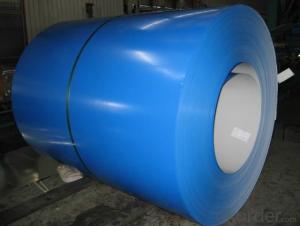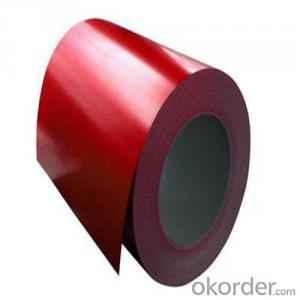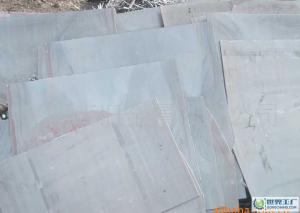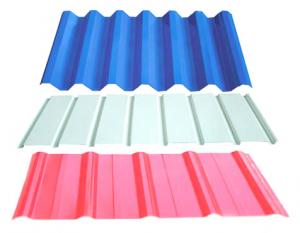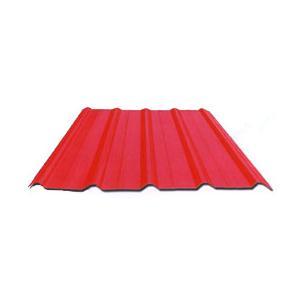FDPRE-PAINTED ALUZINC STEEL COIL
- Loading Port:
- Tianjin
- Payment Terms:
- TT OR LC
- Min Order Qty:
- -
- Supply Capability:
- 8000 m.t./month
OKorder Service Pledge
OKorder Financial Service
You Might Also Like
PRE-PAINTED ALUZINC STEEL COIL PRE-PAINTED ALUZINC STEEL SHEET
THICKNESS:0.18mm-1.5mm
WIDTH:900mm-1250mm
COATING MASS:AZ30-AZ180
PAINT:PE、HP、HDP、PVDF、SMP、MATT、PVDF
COLOR:RAL Scale
COIL INNER DIAMETER:508mm/610mm
COIL WEIGHT:3mt-7mt
BASE MATERIAL:Hot-dip Aluzinc Steel
In continuous units in cold rolled steel strip, galvanized steel (electro galvanized and hot dip galvanized) as substrate, after surface pretreatment (degreasing and science processing), using the method of roll coating, coated with a layer or multi-layer liquid coating of plate, after baking and cooling income is the coating steel plate. Because the coating can have a variety of colors, on the habits of the coated steel sheet is called color coating steel plate. Because the coating is carried out before the sheet metal forming, in foreign countries which is called pre coating plate.
Color coated steel sheet is an organic coating coating on the steel surface, it has the advantages of beautiful appearance, bright color, high strength, good corrosion resistance, easy processing molding, but also allows the user to reduce costs, reduce pollution.
From the United States in 1935 to establish the first continuously coated steel line to begin, color coated steel plate has been widely applied, the current color coated plate varieties, about more than 600 kinds, the advantages of color coated sheet and organic polymer and steel plate of the two, which has good colorability, organic polymer molding, corrosion resistance and decorative, and steel plate with high strength and easy processing, can easily be punching cutting, bending, deep drawing processing. Made this makes organic coated steel sheet products have excellent practical, decorative, workability, durability.
- Q: How are steel sheets protected during cutting and fabrication?
- To ensure the quality and prevent damage, various methods are employed to protect steel sheets during cutting and fabrication. One widely used approach is galvanizing, which entails applying a zinc coating to the surface of the steel sheet. This zinc coating acts as a barrier against corrosion and other forms of harm, making it particularly effective in outdoor settings where steel sheets are exposed to moisture and harsh elements. Another technique for safeguarding steel sheets during cutting and fabrication involves the use of lubricants or coolants. These substances are applied to both the cutting tools and the steel sheet itself to reduce friction and minimize heat generation. By doing so, lubricants and coolants help prevent warping and distortion of the steel sheet during the cutting and fabrication process. Moreover, protective films or tapes are often utilized during the fabrication of steel sheets. These films or tapes shield the sheets from scratches, abrasions, and other physical damage that may occur during handling or transportation. In addition to these methods, proper handling and storage practices play a crucial role in protecting steel sheets during cutting and fabrication. It is essential to store the sheets in a controlled environment to prevent exposure to damaging elements such as moisture and extreme temperatures. Additionally, they should be handled with care to avoid impacts or bending that could compromise their structural integrity. In summary, steel sheets are protected during cutting and fabrication through the combined use of surface coatings, lubricants or coolants, protective films or tapes, and proper handling and storage practices. These measures ensure the quality and durability of the sheets, allowing them to maintain their integrity throughout the fabrication process and beyond.
- Q: What is the process of polishing steel sheets?
- Achieving a smooth and shiny finish on steel sheets involves a series of steps. Firstly, the surface is cleaned to eliminate any dirt, oil, or debris, typically by employing a degreaser or solvent. Following this, abrasive materials like sandpaper or a sanding belt are utilized to sand the sheets, thus eliminating visible scratches and imperfections. Once sanded, a polishing compound or paste is usually applied and rubbed into the surface with a cloth or buffing wheel. This compound aids in removing any remaining scratches and revealing the natural shine of the steel. To further enhance the shine and smoothness, a finer polishing compound may be employed, repeating the process until the desired level of polish is achieved. Finally, the sheets are meticulously cleaned and inspected to ensure they meet the desired quality standards, including the removal of any remaining polishing compound residue and the identification of any remaining imperfections. In conclusion, the process of polishing steel sheets necessitates careful cleaning, sanding, and polishing to attain a smooth and shiny finish. The specific techniques and materials employed may vary depending on the desired level of polish and the type of steel being polished.
- Q: What is the average wind load capacity of steel sheets?
- The average wind load capacity of steel sheets can vary depending on various factors such as sheet thickness, size, shape, and the specific steel material used. It is typically determined by conducting engineering calculations and considering local building codes and standards. Therefore, it is not possible to provide a specific average wind load capacity without knowing the specific details of the steel sheets in question.
- Q: What is the typical hardness range for steel sheets?
- The hardness range of steel sheets varies depending on the specific grade and type of steel employed. Generally, steel sheets exhibit a hardness range of 150 to 250 on the Vickers hardness scale (HV), striking a favorable balance between strength and formability. This characteristic renders steel sheets appropriate for a diverse array of applications. It is worth emphasizing that the hardness can be further modified through different heat treatment methods to attain desired properties.
- Q: Are steel sheets resistant to impact and vibration?
- Yes, steel sheets are generally highly resistant to impact and vibration due to their strength and rigidity. The properties of steel make it a durable material that can withstand heavy loads and external forces without significant deformation or damage.
- Q: How are steel sheets stored and transported?
- Steel sheets are typically stored in large warehouses or outdoor storage areas. They are commonly stacked on pallets or stored vertically in racks to maximize space efficiency. To prevent corrosion and damage, the sheets are often covered with protective coatings or wrapped in plastic sheets. When it comes to transportation, steel sheets are usually moved using forklifts or cranes. They are loaded onto trucks, flatbed trailers, or shipping containers for long-distance transportation. Strapping or securing mechanisms are used to ensure stability during transit, minimizing the risk of damage.
- Q: Can the steel sheets be easily formed into decorative panels?
- Yes, steel sheets can be easily formed into decorative panels.
- Q: Can steel sheets be used in the construction industry?
- In the construction industry, steel sheets are commonly employed. These sheets are incredibly versatile and find extensive use in construction. They serve various purposes, including roofing, wall cladding, flooring, and structural components like beams, columns, and trusses. Steel sheets are favored owing to their exceptional strength-to-weight ratio, durability, and resistance to corrosion. They possess the ability to endure heavy loads and offer stability and structural integrity to buildings. Moreover, steel sheets can be easily fabricated, enabling customization and facilitating efficient construction processes. All in all, steel sheets are widely embraced in the construction sector due to their numerous advantages and suitability for diverse construction applications.
- Q: How do steel sheets handle electromagnetic interference?
- Steel sheets can act as a shield against electromagnetic interference due to their high electrical conductivity and magnetic properties. They can effectively block or attenuate electromagnetic waves, reducing the impact of interference on electronic devices or systems.
- Q: How do you calculate the weight of a steel sheet?
- The weight of a steel sheet can be calculated by multiplying the length, width, and thickness of the sheet, and then multiplying that result by the density of steel.
Send your message to us
FDPRE-PAINTED ALUZINC STEEL COIL
- Loading Port:
- Tianjin
- Payment Terms:
- TT OR LC
- Min Order Qty:
- -
- Supply Capability:
- 8000 m.t./month
OKorder Service Pledge
OKorder Financial Service
Similar products
Hot products
Hot Searches
Related keywords
